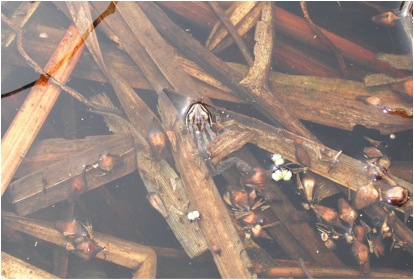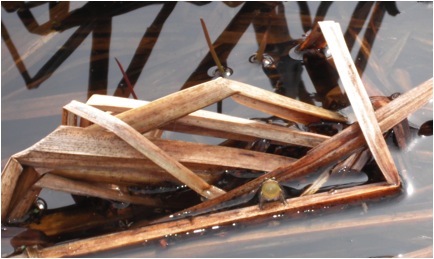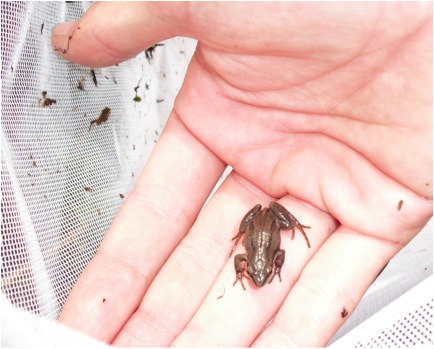Chorus Frog
Contact
Katharine Ordway Natural History Study Area9550 Inver Grove Trail Inver Grove Heights, MN 55076 651-455-6204 (On Site)
651-696-6230 (On Campus)
andersonm@macalester.edu
Biotic Inventory: Documenting Diversity at the Katharine Ordway Natural History Study Area
Pseudacris triseriata



Taxonomy
Scientific Names
Pseudacris triseriata and Psudacris maculata (subspecies)
Common names: Western Chorus Frog and Boreal Chorus (subspecies); and Striped Chorus Frog1
•Kingdom: Animalia
•Phylum: Chordata
•Subphylum: Vertebrata
•Class: Amphibia
•Order: Anura
•Family: Hylidae
•Genus: Pseudacris
•Species: P. triseriata
•P. maculata (sub species)
Diagnostic Characteristics
Tadpole Identification:
P. triseriata and P. maculata have eyes on the margins or lateral portion of their bodies as opposed to having eyes inset, toward the middle of their bodies. They are round shaped, brown or gray colored, with a transparent bronze through which their intestine coil can be seen. Their bodies and tails often have golden or dark colored flecks. They can reach up to 3 centimeters in length. 12
Adult Frog Identification:
P. triseriata ranges in size from 1.9 to 3.9 centimeters in length, and since it is sexually dimorphic the females are larger than males. P. triseriata is bilaterally symmetrical. Their body color ranges from tan, gray, olive, gray-green, and green. Their underside is white and sometimes has dots on the throat or chest.12
This species is distinguished by three wide, dark stripes that run down the center of the back. Sometimes, these stripes can be broken up into segments, or are a series of dots. There is also a dark stripe that runs along the outside of its body from the nostrils, through its eyes, and down to the groin. The front and back legs have dark circular markings like a leopard. They have long, rounded toes that have almost no webbing between them, and have no toe pads. 134
P. triseriata has a very distinct, loud call that sounds like a finger running over the teeth of a comb. These calls last a few seconds, with a short pause in between each call, and increase in frequency, pitch, and volume with each new call. The males have a bright yellow voice sac that is displayed when they are calling, and it looks like a loose flap of skin when not in use.135
Pseudacris triseriata and Psudacris maculata Subspecies:
These two sub species are both found in Twin Cities, and are difficult to tell apart because they have similar coloring, and are about the same size. However, there are several characteristics that can be used to tell them apart. One way to tell these two subspecies apart is by looking at the length of the tibia. In P. maculata, the tibia is shortened in comparison to the tibia of P. triseriata. The shortened tibia in P. maculata allows the frog to hop, but not leap. These frogs can also be identified using the male’s mating calls. P. maculata’s call has a longer call (~.9-1.2 seconds) than P. triseriata’s call (~.6-.8 seconds). P. triseriata and P. maculata’s can be found allopatrically and sympatrically, and in both cases studies have found that these two sub species rarely interbreed because they can distinguish between each other because they have different mating calls. In the wild their ranges have been found to not overlap, even if they are in the same area.345
Ecology
Habitat:
P. triseriata lives in temperate forests, swamps, grasslands, and marshes during its adult life. During its tadpole and froglet life stages it is found in shallow ponds, temporary pools, ditches, marshes, swamps, river backwaters, and lake edges. P. triseriata is found in both rural, urban, and agricultural areas. 123
Habitat Health:
P. triseriata is sensitive to fluctuations of toxins and nutrients in its environment since its skin is permeable, so it is often used to judge the health of an area in much the same way as a canary in a mine. Also, since it has multiple life stages that occupy different habitats and different levels of the food change, adverse affects to this species can be traced to either a terrestrial or aquatic problem.13
Behavior:
P. triseriata stays in close proximity to its breeding/hatching grounds throughout the year. P. triseriata hides from predators under leaves, vegetation, rocks, soil, and in animal burrows. These frogs prefer to lay eggs in temporary pools because there are fewer predators, however this is risky if the pools do not form certain years. They rely on camouflage with their environment and speed to escape predators.13
During mating season they are active both at day and night. During the spring and fall they are diurnal, and in the hot summer they are nocturnal. They metamorphose in the spring or summer, and reach sexual maturity by their second or third year.2
Prey:
Tadpoles feed mostly on algae. Tadpoles undergoing metamorphosis rely on nutrients from their receding tail for food. Adults feed on a variety of terrestrial and aquatic insects: spiders, coleopteran, dipterans, hemipterans, aquatic larva, mites, midges, lepidopteron (both adult, and larval form) leafhoppers, and springtails.13
Predators:
P. triseriata are lean muscled, and soft bodied, so they are a very tasty snack to a variety of predators. Adults are preyed upon by birds (great blue herons (Ardea herodias), small mammals (raccoons Procyon lotor), and snakes. Other frog species, turtles, larger fish, crayfish, and dragonfly larvae prey upon tadpoles and froglets.1
Life History
Reproduction:
The breeding season of P. triseriata is from March to May depending on the region where P. triseriata is found. Once the female’s eggs are fertilized, she will lay 500-1500 eggs in clusters of 20-300 eggs that are covered in a gelatinous case that is anchored to a substrate or vegetation. Depending on how warm the water temperature is (the warmer the water, the faster the eggs hatch) the eggs will hatch within 3-14 days. Then it will take from 40-90 days for the tadpoles to grow, and then metamorphosis into adults.12
As adults, P. triseriata live in terrestrial environments and live for five years, and hibernate during the winter.1
Distribution
P. triseriata has the widest ranges of the tree frogs. They can be found in much of Canada and the west, mid-western, southern, and south eastern United States. There is another These frogs are so wide spread because they have been successful at adapting to a wide variety of climates, in part due to their ability to hibernate and emerge from hibernation even when temperatures are low, and also due to in part to their generalist eating and habitat needs. The range of P. triseriata and P. maculata crosses in the middle section of Minnesota.13
Voucher Information
This specimens were collected at Katheirne Ordway Natural History Study Area in Inver Grove Heights, Minnesota. The specimen was found near the field station by both a prairie and forest habitat. The specimens were collected in a shallow marsh/pool that was about 3-10 inches deep. The specimens were often found underneath tufts of grass that grew out of the water.
References
1. Gardiner, Kevin. “ADW: Pseudacris Triseriata: Information.” Animal Diversity Web. 2008. Web. 25 Apr. 2010. <http://animaldiversity.ummz.umich.edu/site/accounts/information/Pseudacris_triseriata.html>.
2. Cossel, John. “Pseudacris Maculata.” 1999. Web. 20 Apr. 2010. <http://imnh.isu.edu/digitalatlas/bio/amph/anurans/psma/psmafra.htm>.
Platz, James E., and Don C. Forester. “Geographic Variation in Mating Call Among the Four Subspecies of the Chorus Frog: Pseudacris Triseriata (Wied).” Copeia. 1988. 4 (1988): 1062-1066.
3. Whitaker, John O. “A Study of the Western Chorus Frog, Pseudacris Triseriata, in Vigo County, Indiana.” Journal of Herpetology. 5. 4 (1971): 127-150.
4. “Western Chorus/Boreal Chorus Frog – Frogs & Toads: Minnesota DNR.” Minnesota Department of Natural Resources: Minnesota DNR. Web. 20 Apr. 2010. <http://www.dnr.state.mn.us/reptiles_amphibians/frogs_toads/treefrogs/chorus.html>.
5. Platz, James E., and Don C. Forester. “Geographic Variation in Mating Call Among the Four Subspecies of the Chorus Frog: Pseudacris Triseriata (Wied).” Copeia. 1988. 4 (1988): 1062-1066.